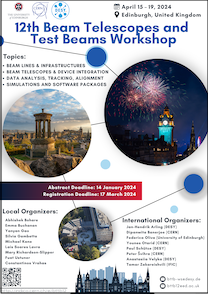Speaker
Description
Monolithic active pixel sensors (MAPS) manufactured in a 65 nm CMOS imaging process are attractive candidates for tracking charged particles at future lepton and electron-ion colliders, as well as for beam telescopes. To investigate this technology and explore the design challenges of porting a hybrid pixel detector architecture into a monolithic chip, the H2M (Hybrid-to-Monolithic) test chip has been developed. The chip matrix consists of 64×16 square pixels with a size of 35×35 μm2 (matrix area of ∼1.25 mm2), and the sensitive region is designed in the so-called n-gap layout to enhance fast charge collection.
Test-beam measurements have been carried out to characterize two of the four available acquisition modes: Time-Over-Threshold (ToT) at SPS and Time-Of-Arrival (ToA) at DESY. This contribution describes the setup and DAQ system used for these measurements. Sensor performance results in terms of detection efficiency, spatial resolution, and time resolution will be shown.
